When seeking to capture awe-inspiring images and push the boundaries of photography, finding the best full-frame camera is an absolute necessity. A full-frame camera not only delivers unparalleled image quality but also opens up a realm of creative opportunities for photographers, from beginners to seasoned professionals. Equipped with a larger image sensor, outstanding low-light capabilities, and an extensive dynamic range, the best full-frame camera stands as the ultimate companion for individuals passionate about photography. In the pages that follow, we will delve into the leading contenders in the world of full-frame cameras, conducting thorough comparisons of their features and performance, enabling you to make an educated choice on the ideal companion for your photographic endeavors.
Top 10 Best Full Frame Cameras Of 2024
| 1 | Sony a7R IV – Best Full Frame Mirrorless Camera |
| 2 | Nikon D850 – Best Full Frame DSLR Camera |
| 3 | Canon EOS-1D X Mark III – The Best Full Frame DSLR For Sports |
| 4 | Sony A9 Mark II – The Best Full Frame Mirrorless Camera For Sports |
| 5 | Sony Alpha a7S III – Best Mirrorless Camera For Video And Low Light |
| 6 | Nikon Z 7 – The Best Nikon Mirrorless Camera For both Video And Stills |
| 7 | Sony a7 C – The Smallest Full Frame Professional Camera |
| 8 | Canon EOS RP – Full Frame Camera Under $1000 |
| 9 | Nikon D750 – Best Budget Full Frame DSLR For Video |
| 10 | Nikon D610 – Best Budget Full Frame DSLR for Stills |
The full-frame camera is considered the standard camera for professional photography and it is preferred by most professionals over cameras with cropped sensors. The reason is that the advantages that a full-frame, 36mm by 24mm image sensor brings are quite compelling. The full-frame sensors with roughly twice the area of the APS-C sensor give photographers a higher resolution capture. And larger sensors mean larger light receptors ( photosites ) for any given resolution. This results in image quality with lesser noise and higher dynamic range. That’s why full-frame cameras give better performance in low-light scenarios.
When it comes to lenses, you get more choices and most often the best lens quality, as lens makers put more effort into lens design for full-frame cameras. Moreover, you can use longer focal length lenses for the same angle of view resulting in a shallower depth of field, that is why these cameras are great for background de-focus effects. These cameras prove invaluable to professionals in various creative fields, be it portrait photography, landscape capture, or videography, due to their unmatched versatility and uncompromising performance. However, their excellence comes at a cost, as full-frame cameras typically command a higher price tag than cameras with smaller sensors, making them a substantial investment for those who demand superior image quality and professional-grade capabilities.
Best Full Frame Camera – Reviews
1. Sony a7R IV

- Key Specification:
- Type: Mirrorless
- Resolution: 61MP
- Sensor: Full-frame CMOS
- Screen Type: 3-inch tilt-angle touchscreen, 21,400K dots
- Lens mount: Sony FE
- Viewfinder: 5,760K dots
- Autofocus: 567 PDAF + 425 CDAF
- Maximum Continuous Shooting Speed: 10fps
- Video: 4K
- Weight: 665 g (1.47 lbs)
- Battery life: 530 Shots
Released in July 2019, the Sony a7R IV is a noteworthy addition to the series of Sony full-frame cameras that are known for their competency. This best full-frame camera is a follow-up to the popular a7R III, a high-resolution full-frame mirrorless camera with a 42.4MP sensor. But A7r IV takes the game of high-resolution sensors to the next level. The a7R 4 comes with a 61MP Exmor R BSI CMOS sensor, a significant increase in resolution, and now holds the crown for the highest megapixel camera.
And despite its high-resolution camera, with its enhanced BIONZ X image processor and 15-stop dynamic range, it can shoot up to 10 fps with full auto-focus. It can shoot UHD 4K video either from the full width of its sensor or from an APS-C/Super 35 crop, both with support for Real-time Eye AF and Tracking AF technologies. Its 16-shot high-resolution mode can also be used to generate 240MP images of static scenes. With its flexible native sensitivity range from ISO 100-32000, the Sony full-frame camera is also capable of working in a variety of lighting conditions.
The Sony mirrorless camera comes with an impressive OLED electronic viewfinder boosted to 5.76m-dots for clear resolution and comes with a 3.0 inch rear tilting touchscreen LCD that has a high 1.44m-dot resolution. Dual SD card slots are both UHS-II-rated for faster performance, and the USB Type-C port allows tethering and quick in-camera battery charging. Additionally, this Sony full-frame mirrorless camera has built-in Bluetooth and both 2.4 and 5 GHz Wi-Fi bands for wireless transferring and remote camera control from mobile devices. With all this, we can confidently say it’s the best high-resolution, full-frame mirrorless camera in the market right now and hence at the top of our list.
You may also want to read: Best Mirrorless Camera
2. Nikon D850
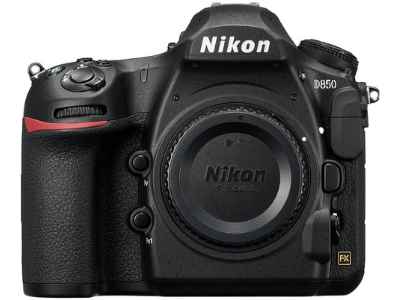
- Key Specifications:
- Type: DSLR
- Sensor: Full-frame CMOS BSI
- Resolution: 45.7 MP
- Viewfinder: Pentaprism
- Autofocus: 153-point AF
- Screen Type: 3.2-inch diagonal tilted touchscreen
- Maximum Continuous Shooting Speed: 7fps
- Video Resolution: 3840 x 2160
- Weight: 1005 g (2.22 lb)
- Battery life: 1,840 Shots
The Nikon D850 is one of the high-resolution full-frame DSLR cameras. And not only one of the best Nikon full frame cameras but the best full frame camera overall. With its 45.7 MP CMOS sensor, it has not compromised its shooting speed. It is capable of 7fps continuous shooting, which can be improved to 9 fps with a battery grip. This best Nikon camera is an all-rounder camera, highly recommended for landscape, nature, and portrait photography. It is also ideal for long exposures on a vibration-free shutter mode, whereas outstanding for night captures with its light-up buttons.
It has a native sensitivity range of ISO 64-25600 with an updated autofocus system of 153 points. However, ISO sensitivity can be expanded up to ISO 102,400. The Autofocus system gives exceptional performance when coupled with the new EXPEED 5 processor. This Autofocus system of the camera actively performs at very low light, even sensitivity down to -4 EV.
D850 can record up to 30 fps in 4K, whereas up to 60 fps in HD. Furthermore, Nikon has also added MP4 video file format to D850, along with MOV format. There are some video-specific features introduced in D850, such as Active D-Lighting, focus peaking, and electronic VR. Along with an Electronic front-curtain shutter, the focus peaking also allows shooting in a live view for capturing stills. At the same time, it is also capable of shooting 4K and 8K time-lapses smoothly. With its EN-EL 15a battery, it can take 1,840 shots once fully charged.
It has built-in Wi-Fi and Bluetooth connectivity but lacks built-in GPS. However, the SnapBridge app helps to connect through remote control. However, it does not support the transfer of RAW files. Dual card slots on the camera are compatible with XQD and SD cards. It also has ports for microphone and headphone connection. The body of the camera is made of a magnesium alloy having a rear touch screen. The carbon fiber chassis gives excellent durability and resistance against harsh weather.
You may also want to read: Best DSLR Camera
3. Canon EOS-1D X Mark III
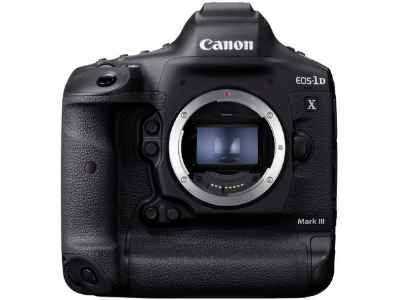
- Key Specifications:
- Type: DSLR
- Sensor: Full-frame CMOS
- Resolution: 20.1 MP
- Viewfinder: Optical Pentaprism
- Autofocus: 191-point AF
- Screen Type: Rear Touchscreen LCD
- Maximum Continuous Shooting Speed: 20 fps
- Video Resolution: 5472×2886 Raw
- Weight: 1440 g (3.17 lbs)
- Batter Life: 2,850
Canon EOS-1D X Mark III is one of the high-end cameras on the Canon full frame cameras list. This 20-mega pixel CMOS sensor has the latest DIGIC X processor capable of shooting continuously at 16 fps with its viewfinder. It can perform like a mirrorless camera, autofocusing and shooting up to 20 fps in a live view mode. The ultra-tough and hyper-fast camera is a good fit for Sports Professional Photographers. With an outstanding native sensitivity range from ISO 100-102400, which can be further extended up to ISO 50-819200, it performs various lighting conditions.
The accuracy and precision make its AF system astounding. It has a high-resolution sensor with the capability of 191 AF points autofocus, 151 of which are cross-type to better perform at high sensitivity. Regardless of the subject’s speed in action, it can quickly adjust the focus to give excellent results.
Another strong point about Canon EOS-1D X Mark III is its performance in video making. It offers full-width 5.5K/60p 12-bit RAW and cropped 4K/60p (UHD and DCI). It is the best option for visual storytellers and filmmakers recording internally, relying on a 10-bit HEVC/H.265 codec with 12-bit Raw. During a video shoot, Dual Pixel AF gives smooth focusing by tapping the screen. Another fantastic feature it shares is image stabilization while filming. The Movie Digital IS gives five-axis image stabilization to jiggle caused by the movement of the camera.
It makes your horizontal or vertical shooting nearly perfect by controlling accidental movements with its pair of smart controllers. It is an all-rounder camera recommended for both video and still photography. The water-proof body and illuminating button allow you to shoot in any weather condition and capture well in the dark. It has an enhanced battery life, allowing you to capture 2850 shots on a single charge. At the same time, this Canon’s best camera is also compatible with older LP-E4N batteries. Its shutter is rated at 500,000 shots. Further, the 3.2″ 2.1 m-dot touchscreen LCD provides menu navigation and intuitive playback. The built-in Wi-Fi, Bluetooth, and GPS allow wireless connectivity, and the built-in Ethernet port is quick for wired LAN file transfer.
4. Sony A9 Mark II

- Key Specifications:
- Type: Mirrorless
- Sensor: Full-frame BSI CMOS
- Resolution: 24 MP
- Viewfinder: Electronic
- Autofocus: 693-point AF
- Screen Type: 3.2-inch tilted angle touchscreen
- Maximum Continuous Shooting Speed: 20 fps
- Video Resolution: 4K
- Weight: 678 g (1.49 lbs)
- Battery Life: 500 shots
The Sony Alpha a9 II was launched mainly targeting sports photography. It is a full-frame mirrorless camera with a 24 MP stacked CMOS sensor. This stacking gives a fast readout speed and enables the camera to burst shooting at 20 fps. Thus, the electronic shutter of the Sony Alpha camera is very helpful in capturing moving subjects. The 693-point autofocus of A9 II is the finest, with almost 93% surface area coverage. A9 II is significant with its faster-performing finder and outstanding resolution; it can complete the shoot in silence without getting smeary or black-out. You can select the silent shutter mode through settings at MENU. Further, the ISO range lies between 50 and 204,800 when expanded.
A9 II is also an outstanding camera for video making. It can record 4K even at 30 fps and 1080p at 120 fps. There are various features for professional videographers to take advantage of the camera, such as slow motion, stabilization, and digital microphones.
It has a pro-grade body made up of magnesium alloy, with capabilities of 5-axis image stabilization and weather shield. The size of the camera is smaller than the same models of other brands. Among the top control buttons, include C1, C2, the Mode dial, and the shutter release. Further, it has a dial for setting drive mode and focus options. The 3-inch tilting screen also supports touch input along with adjustable brightness. However, the touch support is limited, and it can only allow tapping for a focus point, whereas on-screen menus cannot be dealt with by touch.
Moreover, the Sony A9 II also offers Bluetooth and Wi-Fi connectivity if you need cable-free image transfer. It also supports apps like Sony Transfer & Tagging for FTP transfers. You will also find a hot shoe to connect flash, jacks for headphones, and a microphone with an Ethernet port. Apart from these, you will also notice two SDXC memory card slots supporting UHS-II cards. The camera’s battery life is unlimited, allowing up to 5,000 shots when on a full charge.
Also read: Best Sony Lenses
5. Sony Alpha a7S III
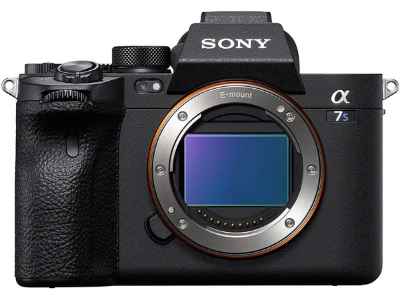
- Key Specifications:
- Type: Mirrorless
- Sensor: Full-frame CMOS
- Resolution: 12.1MP
- Lens mount: Sony FE
- Screen: 3-inch fully articulating touchscreen, 1,440,000 dots
- Viewfinder: Electronic, 9.437m dots
- Maximum Continuous shooting speed: 10fps
- Max video resolution: 4K
- Weight: 21.7 oz (614 g)
- Battery life: 600 stills
Released in the fall of 2020, the Sony Alpha a7S III is Sony’s long-awaited and latest release. With its 12.1-megapixel BSI CMOS sensor, and the Bionz XR image processor, this best full frame camera can shoot 120p 4K 10-bit 4:2:2 video with no limits on recording time, 4K at 60p uncropped recording it internally, and has RAW recording up to 60p 4K (16-bit) via HDMI. Along with its 5-axis in-camera image stabilization technology, it yields sharper shake-free footage even when handheld.
Sony Alpha a7S III is the best low-light camera, a low-light beast that can see in the dark with its maximum ISO ceiling of 409,600. It borrows Sony’s latest Fast Hybrid AF system from the flagship FX9 cinema camera with 759 phase-detect AF points and 93% frame coverage. This system allows real-time tracking for both humans and animals, resulting in the best AF performance of the A7S series. Sony also added superior AF customization options for greater flexibility over the AF transition speed.
It also obtains the new Z-type battery and comes with a 60% improvement compared to its predecessor. It can now shoot 600 stills and 90 minutes of video on a single charge, offering all Alpha cameras the longest recording time. It’s one of the few cameras with H.265 compression. It also has a 3-inch Vari-angle touchscreen, a full-sized HDMI, dual card slots, log profiles, weather sealing, and headphone and microphone inputs.
6. Nikon Z 7
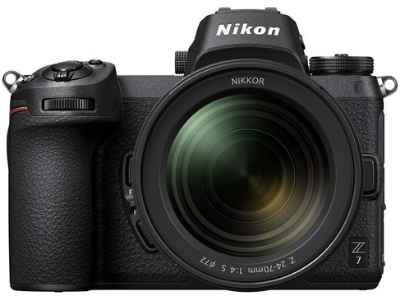
- Key Specifications:
- Type: Mirrorless
- Sensor: Full-frame BSI-CMOS Sensor
- Resolution: 45.7 MP
- Viewfinder: Electronic Viewfinder
- Autofocus: 493-point AF
- Screen Type: 3.2-inch Tilting touchscreen
- Maximum Continuous Shooting Speed: 9fps
- Video Resolution: 3840×2160
- Weight: 675 g (1.49 lbs)
- Battery life: 400 Shots
The Nikon Z7 is a full-frame mirrorless camera and one of the most praised Canon mirrorless cameras ever. It is a highly recommended full-frame camera for both still photography and videography because of its impressive quality results and high performance. It has a smaller and lighter body compared to Nikon DSLRs. It is all set to give a better performance with its 45.7 MP sensor. It has improved sharpening control, brighter colors, and higher contrast in comparison to Nikon DSLRs.
At the same time, this Nikon full frame mirrorless camera has not compromised High ISO performance; the native sensitivity range is ISO 64-25,600, which is further expandable to 102,400. It also uses an EXPEED 6 processor along with a brand-new hybrid autofocus system. The Autofocus system of 493 points covers 90% area of the frame. This Nikon mirrorless full-frame camera is assessed in difficult lighting situations; it was relatively quick in autofocusing in low light. With its 5-axis in-body image stabilization, it can give the best stills and videos. As the continuous shooting performance of the Z7 is 9 fps, the speed is comparatively better than the 7 fps of the Nikon D850. However, the burst rate varies depending on image quality settings, like using the mechanical or electronic shutter.
For videography, the Z7 can record 4K UHD at 30 fps and Full HD videos at 120 fps, just like the D850 but with improved AF enhances both single shot and continuous autofocus during video making. The 3.2-inch screen of the Z7 has a better resolution of 2100k dots. Also, it has a touchscreen allowing AF and shutter touch. However, storage media can be problematic, as the Z7 has only one XQD memory card slot. The battery life of mirrorless cameras is comparatively low. Where Nikon DSLR can shoot up to 1840 shots on a single charge, Z7 is only capable of 330 shots. However, for a live view, the battery of the Z7 is ready to compete with the D850.
Also read: Best Nikon Lenses
7. Sony a7 C
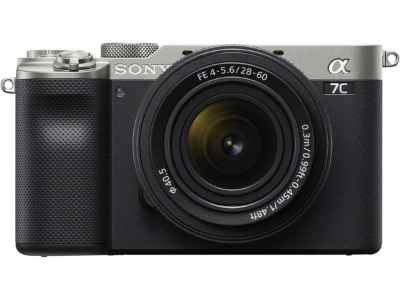
- Key Specifications:
- Type: Mirrorless
- Sensor: Full-frame BSI-CMOS
- Megapixels: 24 MP
- Lens mount: Sony E
- Screen: 3-inch fully articulating touchscreen, 921,600 dots
- Viewfinder: Electronic, 2.4 million dots
- Maximum Continuous shooting speed: 10fps
- Max video resolution: 4K
- Weight: 18.0 oz (509 g)
- Battery life: 640 shots
Sony A7 C is an exciting addition to the Alpha lineup that started with the release of the A7 and A7R back in late 2013. With a 24 MP sensor, It’s said to be the smallest full-frame camera in the market right now. But it’s the right kind of the smallest camera because despite being small, its grip is good, and even with a large lens on, it gives a feel just as good as Sony’s a6600.
The best full-frame camera features the same hybrid autofocus system as higher-end models, with “Real-time Tracking” and Eye AF for humans and animals. The camera’s speed is impressive, and it can burst to shoot 115 RAW images at 10 fps with autofocus. With an ISO range of 100 to 51,200 that can extend up to 204,800, The A7C is an excellent shooter in low-light situations.
The camera comes with a 3-inch fully articulated touch screen. There is a standard Sony camera’s five-axis system in-camera stabilization. The Sony a7 c can shoot 4K 4:2:0 8-bit video at 24Ffps and 30fps, but you will have to drop down to 1080p to get 120fps or even 60fps. With solid battery life, it records in 4K for well over an hour and a half (with no overheating), which is exceptional. The camera has a full-sized HDMI, a single card slot, log profiles, weather sealing, and headphone and microphone inputs.
The big sensor, powerful autofocus, 10 frames per second speed, and the ability to shoot at high ISO make it an excellent performer. But what makes this camera exceptional is all this experience in a smaller body.
8. Canon EOS RP

- Key Specifications:
- Type: Mirrorless
- Sensor: Full-frame CMOS
- Resolution: 26.2 MP
- Lens mount: Canon RF
- Screen: 3-inch vari-angle touchscreen, 1,040,000 dots
- Viewfinder: 2.36m-Dot OLED Electronic Viewfinder
- Maximum Continuous shooting speed: 4.7fps
- Max video resolution: 4K
- Weight: 485 g (1.07 lb)
- Battery life: 250 stills
Canon EOS RP is still the cheapest full-frame camera at its release, and still one of the smallest full-frame cameras around. With its 26.2 MP sensor and DIGIC 8 processor, this best full-frame camera can provide its user with a shallower depth of field than full-frame sensors provide, and the image quality is excellent. Its users are going to enjoy some excellent JPEGs.
Despite its small size, the Canon full-frame mirrorless camera comes with a firm grip and a solid body that offers twin command dials. At the same time, its 3.0-inch vari-angle touch screen allows capturing pictures from different angles, making it an ideal choice for entry-level photographers who want an entry-level full-frame camera.
This Canon mirrorless camera’s built-in EVF is bright and produces sharp colors and contrast. Unlike its rival Sony a7 II, the camera offers 4K, though from a cropped sensor. Though its Autofocus is impressive for stills, it doesn’t impress in the video. This Sony 4K camera uses slow and unreliable contrast detection. But in 1080p things get better, you can shoot 1080p at 60p and 30p. And dual pixel autofocus with its tap-to-focus option allows you to render excellent video results.
For connectivity, the camera comes with built-in wifi and Bluetooth, and with Canon’s Connect App, you can easily transfer files between your cell phone for social media sharing. At the same time, the camera comes with a built-in mic and headphone jacks, and its USB-C port supports charging, which is good because the camera’s battery life isn’t that impressive. It can shoot 250 shots per charge, and for that reason, we would highly recommend you keep an extra battery. Overall, Canon mirrorless full-frame is an exceptional camera for its price and the best budget full-frame camera option for those wanting to start the full frame.
Also read: Best Canon Lenses
9. Nikon D750

- Key Specifications:
- Type: DSLR
- Sensor: Full-frame CMOS Sensor
- Megapixels: 24.3 MP
- Viewfinder: Pentaprism
- Autofocus: 51-point AF
- Screen Type: 3.2-inch diagonal tilted touchscreen
- Maximum Continuous Shooting Speed: 6.5 fps
- Video Resolution: 1920 x 1080 megapixels
- Weight: 755 g (1.7 lbs)
- Battery life: 1,230 shots
The Nokia D750 is made for those looking for a full-frame DSLR camera, allowing them to switch between stills and video without compromising the quality. With its 24.3 MP CMOS Sensor, the camera’s EXPEED 4 processor promises to produce high-resolution images with low noise and smooth color progressions. The native sensitivity range of the Camera is ISO 100-12,800, which can be extended to ISO 51, 200. Thus, the sensor and processor are paired up to improve the speed and give full resolution with a continuous shooting speed of 6.5 fps.
It has a powerful Autofocus System of 51-point, with 15 cross-type sensors. However, it can utilize 5 AF points as one focusing point in the Group Area AF setting to heighten initial subject recognition. The D750 is also capable of time-lapse movies with the ability of automated exposure smoothing. The 3.2-inch screen is a 12,29k dot tilting Vari-angle display that uses a compatible phone as a remote control for live-view shooting.
Likewise, the professional video abilities make the D750 the best camera for filmmaking on a budget. With its EXPEED 4 processor, it is capable of Full HD 1080p video shooting in multiple frame rates at the max of 60 fps. At the same time, it is possible to manually control ISO, aperture, and shutter speed during a recording. There is an in-camera stereo microphone with an alternative capacity of input for an external stereo microphone for audio recording. With it, it is now feasible to adjust sound levels during a recording. With Dual SD card slots, it assists in file saving or in-camera file duplicating. Moreover, with its built-in Wi-Fi and remote control, it is easier and faster to share photos and videos from the D750. It also has a built-in pop-up flash that adds illumination to scenes when needed.
10. Nikon D610
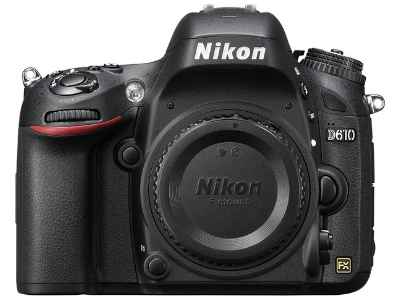
- Key Specifications:
- Type: DSLR
- Sensor: Full-frame CMOS Sensor
- Resolution: 24.3 MP
- Viewfinder: Optical
- Autofocus: 39-point AF
- Screen Type: 3.2-inch fixed screen
- Maximum Continuous Shooting Speed: 6fps
- Video Resolution: 4K
- Weight: 850 g (1.87 lbs)
- Battery life: 900 Shots
At last, the best full-frame camera for professional photography on our list is Nikon D610. The D610 was released as a full-frame camera by Nikon in 2013. It was an updated version of D600 with improved shutter speed and focus setting. It can continuously shoot at 6 fps.
Furthermore, it has an improved auto white balance system that helps the camera in artificial lighting to give more accurate colors and realistic skin tones. Photos and videos of good quality are usually defined as razor-sharp with minute details captured at once. The 24.3 MP FX-format CMOS sensor of D610 gives high-quality pictures and videos. Its long-range ISO produces incredible photos and videos regardless of low contrast, low light, and high noise conditions. The native sensitivity range of the Camera is ISO 100-6400, whereas the expanded range is 50 to 25,600.
The D610 also marks that the EXPEED 3 processing system of Nikon performs exceptionally with an impressive speed. The stored data is transferred within seconds. It shoots 1080p HD videos at 24p or 25p. Along with landscape and still life photographers, those who compose images in a live view mode will like its 3.2-inch, 921,000-dot LCD screen. It can support four live views AF modes, including Face-priority AF, Wide-area AF, Normal-area AF, and Subject-Tracking AF. However, the camera only supports JPEG images only. For Wi-Fi, it offers a WU-1b Mobile Adapter option, which allows connectivity through remote control.
Further, it has headphones and microphone ports. It is dust-like splotches formed on the lens that also affects the photo and video quality. It has a built-in flash with two SD slots. Though the inner frame of the camera is magnesium alloy, the outer shell is mostly plastic.
Buyers Guide: Things to consider before buying the best Full Frame Camera
Before buying the best full-frame camera in 2024, there are several unique and creative factors to consider:
Lens Compatibility
Full-frame cameras offer a wide range of lens options. Research the available lenses and lens mount compatibility for the camera you are considering. Consider the availability, quality, and cost of lenses for your specific needs.
Video Capabilities
If you’re interested in videography, consider the camera’s video features. Look for high-resolution options, frame rates, and video formats supported. Features like in-body stabilization and external microphone ports can enhance your video recording experience.
Image Quality
Full-frame cameras offer excellent image quality, but different models may have varying resolutions and sensor technologies. Consider factors like megapixels, dynamic range, noise performance, and low-light capabilities to ensure the best full-frame camera meets your image quality expectations.
Low-light performance
Full-frame cameras generally perform better in low-light situations due to their larger sensors. Consider the ISO range and noise performance of the camera, especially if you frequently shoot in challenging lighting conditions.
Ergonomics and usability
Ensure that the camera feels comfortable in your hands and has intuitive controls. Look for features like touchscreen interfaces and customizable buttons for easier and faster operation.
Battery life
Check the battery life of the camera to ensure it can last for extended shooting sessions without constantly needing to recharge or carry spare batteries. Consider the availability of additional battery options or battery grips.
Brand Reputation and Support
Research the reputation of the camera brand and its customer support services. Consider factors like reliability, warranty, and the availability of firmware updates and accessories.
People Also Ask
Which one to go for, mirrorless or DSLR, when buying a full-frame camera?
DSLR users have long debated that DSLR’s optical viewfinder gives them a more realistic view of the scenery compared to the processed view of the Electronic viewfinder of mirrorless cameras.
Moreover, DSLRs were preferred for their better autofocus, especially for sports and wildlife photography, which some still believe to be true. But In the past couple of years, it seems as if mirrorless cameras are settling up the long-lasting debate of which of the two is the better one, in its favor. Because mirrorless cameras now have electronic viewfinders that give you a view as realistic as DSLRs, autofocus has improved significantly, offering even more potential in the future with its advanced phase and contrast detection.
But again it’s about preferences, as some DSLR users still prefer them because they find rugged and heavy bodies of DSLRs better suitable for bigger lenses as compared to smaller and lighter bodies of mirrorless cameras. Also, old DSLR users might find their muscle memory more helpful in their photography than the new advanced specs. But one thing is for certain DSLRs do give a better battery life than Mirrorless cameras and for some that could be a decisive component.
For stills photographers, both DSLRs and mirrorless have some amazing options, but when it comes to video, mirrorless cameras certainly have the edge over DSLRs. Their autofocus works well for videos. But again they offer lesser battery life which should also be considered along with the recording times and codecs.
Brand and lens system: Why is it important?
Choosing the right brand is important because every brand comes with a mounting system and would accept only compatible lenses. Bigger brands like Sony, Nikon, and Canon are preferred because they have well-established lens system lines and offer adapters if you want to use your old DSLR lenses in your new mirrorless camera. There are also many other amazing brands like FujiFilm, Pantex, and Panasonic. But, whichever brand you choose, you must dig into its lens system before finalizing your choice.
You may like to read: Types Of Camera Lenses
What are the advantages of a full-frame camera over cameras with cropped sensors?
The best full-frame cameras have several advantages over cameras with cropped sensors. They offer higher resolution, better low-light performance, larger light receptors for improved image quality, and a wider selection of lenses with superior quality.
Can full-frame cameras use lenses designed for cropped sensors?
The best full-frame cameras can use lenses designed for cropped sensors, but there may be limitations. When using lenses designed for cropped sensors on a full-frame camera, the image may appear vignetting, which is a darkening of the corners. However, most full-frame cameras offer.
Final Thoughts
Leading the way in performance, features, and value, our top picks will elevate your photography to new heights. From high-resolution powerhouses like the Sony a7R IV to the sports-focused Sony A9 Mark II, there’s a perfect match for every photographer. You can capture stunning detail with the Nikon D850 or unleash your creativity in low light with the Sony Alpha a7S III. Choose the best full-frame camera that speaks to your vision and embrace the full-frame revolution.
Related Articles:







